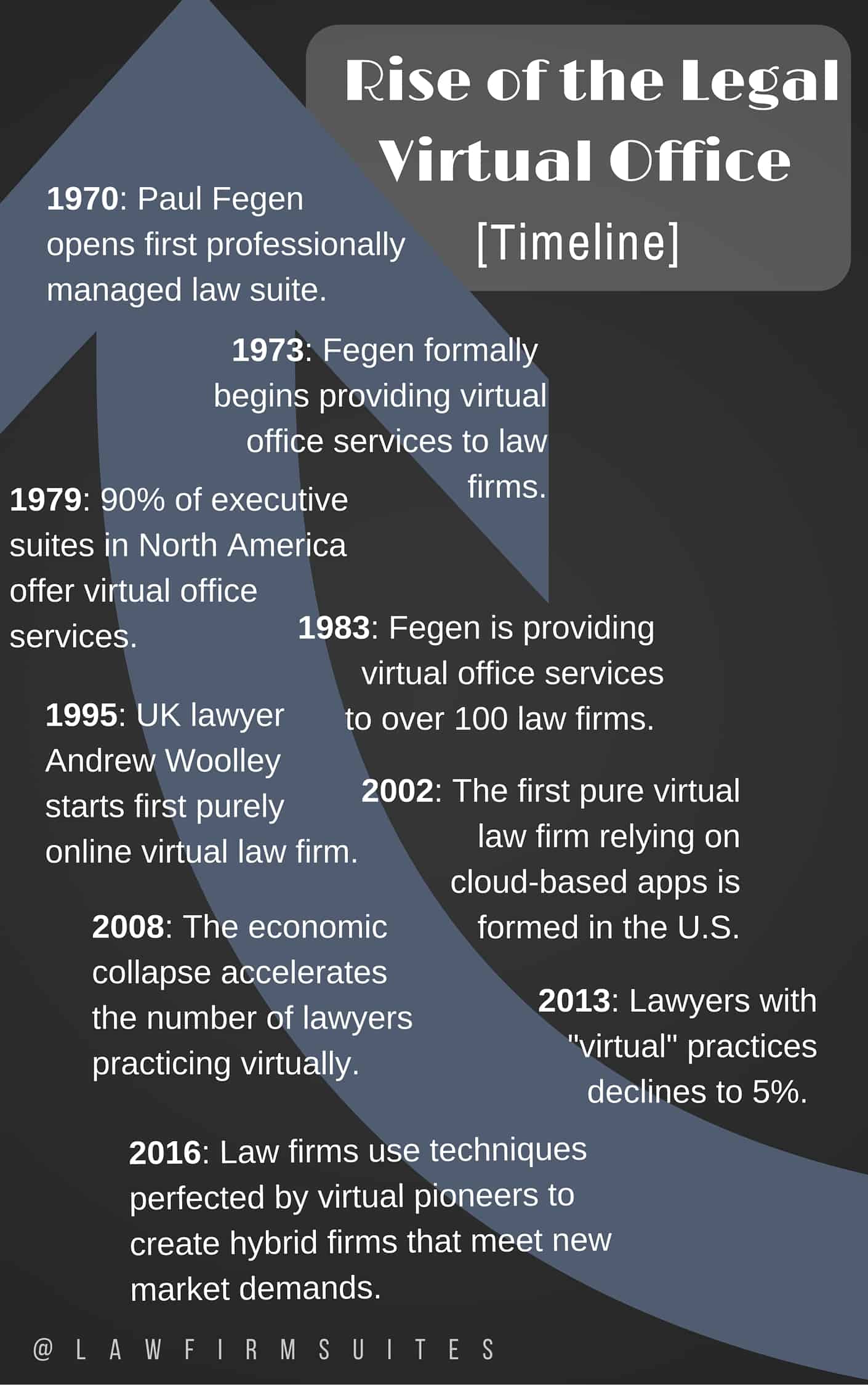We traced the origins of the legal virtual office to learn how it all started.
As technology advances, more and more people have been freed from traditional brick-and-mortar offices, opting instead for a home office with a virtual office address. According to statistics, more than two-thirds of U.S. workers are engaged in some virtual work, and many of these working professionals are solo attorneys.
The rise of the legal virtual office has provided solos with a flexible, cost-effective office arrangement that allows them to practice from anywhere. An attorney can offer services in multiple states or work from a home office in the suburbs, while still maintaining their professional presence in a big city. The virtual office has opened many doors for lawyers–doors that will always be open.
But where did this brilliant idea come from? How did it evolve over time? We’ve traced the origins of the virtual office and outlined how it became the preferred office arrangement for many attorneys today.
Legal virtual office throughout history
1970
California attorney, Paul Fegen, launched the first of his many full-floor, full serviced law office suites called Attorney Office Management, Inc. Fegen was considered by many to be the founding father of today’s shared law office suite.
1973
Fegen began providing virtual office services to law firms after one of his tenants wanted to partially retire. He charged $100 per month for mail collection, full access to conference rooms and other amenities, plus an additional $100 per month for phone answering services.
1979
The idea of virtual office continues to grow in popularity among other executive suites. Approximately 90% of the over 500 “executive suite” operations in North America begin to offer some form of virtual office services.
1983
The number of attorneys taking advantage of virtual office arrangements increases. Fegen was providing virtual office services to over 100 law firms in his Beverly Hills law suite, with three full-time staff members dedicated to the company’s virtual clientele.
1995
Technology and the Internet could now support a law firm’s full detachment from a physical office, making the Pure Virtual Practice possible.
1996
Andrew Woolley started the Pure Virtual Law Firm movement by creating the “first recorded virtual law firm.” His firm, Woolley & CO., completely abandoned the bricks-and-mortar office and became the first to fully replaced a traditional office with technology.
Late 1990’s
The term “virtual office” became a common part of the industry lexicon.
2002
FisherBroyles LLP became the first full-service, Pure Virtual Law Firm relying exclusively on cloud-based applications formed in the U.S.
2005
Virtual Law Partners, Rimon P.C and several other small firm practitioners followed in the footsteps of FisherBroyles LLP and also opened Pure Virtual Law Firms using cloud-based applications.
2008
The number of lawyers practicing virtually accelerated with the economic collapse. As Internet bandwidth increased and software applications became more available, the virtual law practice grew to become an even more affordable option for recent law school graduates who could not find jobs.
2011
There were an estimated 200 to 300 Pure Virtual Law Firms in the U.S., in addition to the hundreds of attorneys practicing virtually and maintaining a virtual law office address.
2013
The number of lawyers who describe their practice as being “virtual” declined to 5% from 7% the year prior. Solo practice thought leader, Carolyn Elefant, attributed the decline to a faulty business model. She found virtual lawyers could not sustain their practices if they relied on a series of low-end, one-off cases.
2016
The virtual practice movement produced a pattern of innovation within the entire legal industry. More lawyers are integrating technology into their firms to increase efficiencies and maximize profits, such as using online client portals. Today, law firms, both virtual and traditional alike, now use techniques perfected by virtual pioneers to create hybrid firms that meet new market demands.
Legal Virtual Office in the future
The low cost and flexibility of legal virtual office will solidify its place in the future of the profession. There will always be attorneys who must rely on virtual practice to make their lives easier, whether it’s to allow them to spend more time with the kids or hang a shingle on a shoestring budget.
Before the virtual office, lawyers had to figure out a way to find time for their actual lives outside of working at their law firm. Now, they’re able to fit their profession into their lifestyle instead of the other way around.
To learn even more about the history of virtual office, check out this write up by Alliance Virtual. If you have anything to add to the development of the legal virtual office, let us know in the comments!

![History of the Legal Virtual Office [Infographic]](https://lawfirmsuites.com/wp-content/uploads/2016/02/History-of-the-Legal-Virtual-Office-1040x496.jpg)

